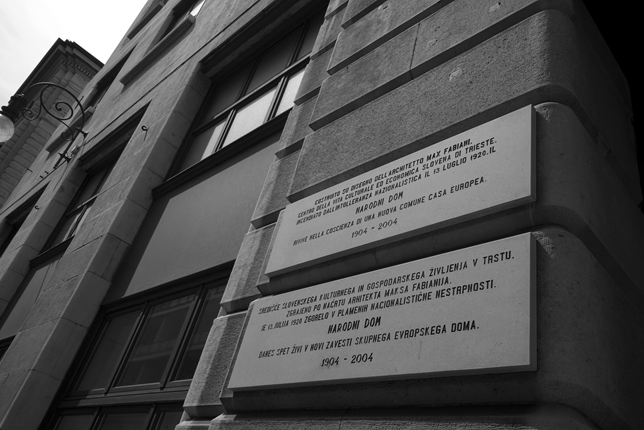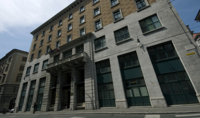
A plaque commemorating the fire in 1920 and the repression suffered by the Slovenian minority has been affixed next to the main entrance of the Narodni dom. It ends with the phrase "The Narodni Dom lives again in the consciousness of a new common European home 1904-2004", inaugurating the European future of the city. Indeed, the centenary of the building's construction coincided with the year of Slovenia's entry into the European Union – photo by Andrea Pandini
A building designed to celebrate a community that was an important component of the city fabric. And that is why it was set on fire in 1920 by those who wanted to paint Trieste as an exclusively Italian city. Now the Narodni dom has been returned to the Slovenian community
One hundred and two years later, history comes full circle. The Slovenes of Trieste regain possession of the Narodni dom, the Hotel Balkan, set on fire by the fascist squads in 1920 in what was the prelude to the sad season of "border fascism" and fascist violence throughout Italy.
That fire marked an (almost) irremediable fracture that first presidents of Italy and Slovenia Giorgio Napolitano and Danilo Turk and then their successors Sergio Mattarella and Borut Pahor have metaphorically recomposed. Now the building in Via Filzi, built in 1904 and designed by architect Max Fabiani – one of the leading interpreters of Central European architecture – has been returned to the Slovenian minority, or more precisely the foundation that will manage the Narodni dom. The signing of the deed of transfer of ownership, which took place last Monday, was attended by the Italian head of state himself, while the Slovenian one did not fail to express his satisfaction.
Now we will have to wait for the transfer of the Section of Studies of Modern Languages for Interpreters and Translators to its new headquarters. The building will be vacated within ten years, but everyone is hoping this will take a shorter time. Then it will be up to the Slovenian community to fill the Narodni dom again with content. It will be a great challenge for all Slovenes in Italy, who will have to be especially careful not to let themselves be drawn into the vortex of the selfishness of their various organisations and the traditional acrimony between the centre-left and the centre-right components of the minority.
The intent, of course, is to return the building to its former glory, when it not only managed to support itself thanks to a range of commercial activities, including the cafeteria, the hotel, the restaurant, and apartments for rent, but above all to be the symbol of Slovenes and generally of the Slavic presence in the city.
The Narodni dom was built with the clear intention of giving prestige to a community that had become an important component of the city fabric with its cultured and refined bourgeoisie. A real insult for those who, after the annexation of Trieste, wanted to present it as an exclusively Italian city. Its return into Slovenian hands will be a way to restore pride to a part of Trieste which since the 1920s has had to fight to maintain its national character. A poorly tolerated presence even after the fall of fascism, as happened during the period of the allied military occupation and even later, as Trieste scrupulously applied, up to the mid-1960s, the Royal decree which forbid to assign foreign names to the new born. While Italians could not give their children exotic names, Slovenian parents were forbidden to name their children according to their own traditions. As if this were not enough, it took several decades to have names and surnames written correctly on identity and other documents, since the use of letters with diacritics (č, š, ž) was forbidden as well.
Beyond these rules, however, there was a terrible climate in the city, where in the sixties, seventies, and even in the eighties people could be told off for speaking Slovenian on the bus or in the streets. Then things began to change, first slowly and then suddenly, even if just recently a controversy broke out in the city council because the Slovenian councillors elected for the Democratic Party, at the opening of the session, used both Slovenian and Italian to greet the hall and introduce themselves. In any case, in real life, things seem much more relaxed, so much so that for many years many Italian families have chosen to enrol their children in Slovenian minority schools. Despite everything, Trieste tries to be more multicultural. Just yesterday, a statue was unveiled dedicated to Josef Ressel, the father of the propeller, who had lived in Trieste and tested his invention there. Despite his Bohemian origins, the Slovenes in the city consider him as one of their own, and that statue is seen as the recognition by the city authorities of the multi-ethnic and Central European essence of the city.
Meanwhile, on the other side of the border, another prestigious building in the heart of Koper is about to end up in the hands of another minority: the Italian one. A few weeks ago, the Slovenian government allocated the funds to buy Palazzo Tarsia, which will become the new headquarters of the organisation representing the Italians of Slovenia. No correlation with the change of ownership of the Narodni dom and probably just a coincidence. The point is that the steps undertaken by Slovenia and Italy for pacification and overcoming the traumas of the past are also bringing benefits to national minorities, that need peaceful relations in order to be able to live peacefully. Now they can no longer be viewed as a threat to national unity. This is true in Italy for the largest Slovenian minority and in Slovenia, where only a small relic remains of what had been the Italian presence before the exodus, which wiped out the vast majority of the population from Piran, Izola, and Koper as well as virtually all the cultural, political, and economic elite of the Italians of Istria. Perhaps, after a season marked by attempts at forced Italianisation and Slovenisation, the time has come to look to the future with a new European spirit, ready to recognise the beauty of diversity and the multicultural, plural nature of border areas.
Il Narodni dom
Built in 1904, the Narodni Dom (National House) was the association centre of the Slovenian community in Trieste. The modern building housed a multifunctional centre consisting of a hotel (the Hotel Balkan, a name used by some to designate the entire building), a theatre, and some private houses, and hosted numerous Slovenian cultural, economic, and political organisations and some Czech, Croatian, Serbian, and Slovak ones.
The palace was the tangible sign of the Slovenian presence in the city. On the eve of the First World War, more than a quarter of Trieste's population – around 56,000 people – was Slovenian: a dynamic community with a growing national awareness.
After 1920, the Narodni Dom became the symbol of anti-Slovenian repression in the period between the two world wars. In the course of the anti-Slavic riots that broke out in Trieste, on 13 July 1920 the building was destroyed by fascist squads who set it on fire and prevented the intervention of the firefighters. The intent was to eliminate what for them was an affront to the Italian-ness of the city and burn down, together with the building, the archives that collected the memory of the Slovenian community of Trieste. Those responsible for the stake were never tried, nor were the owners compensated. Subsequently, the affirmation of the fascist regime led to the complete denial of the rights and identity of minorities and in 1927 the definitive closure of all Slovenian organisations was proclaimed.
After World War II, the Slovenian community tried several times to regain possession of the building that had been expropriated in the 1920s and has now succeeded.







 To Top
To Top